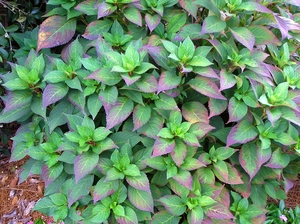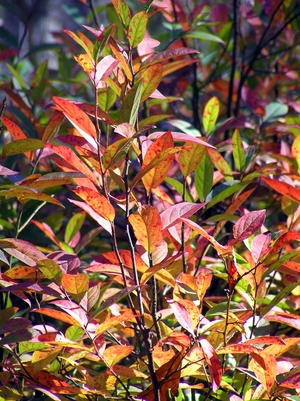I have 3 new fact sheets up at my workplace website. Take a look:
Pretty pictures too. And yes, this does mean it’s time for me to pay attention to this blog again. I’ve neglected it for far too long.
Posted in Gardening, Shrubs, trees, tagged Gardening, Shrubs, trees on February 25, 2010| 3 Comments »
I have 3 new fact sheets up at my workplace website. Take a look:
Pretty pictures too. And yes, this does mean it’s time for me to pay attention to this blog again. I’ve neglected it for far too long.
Posted in Plants, trees, tagged biology, botany, plant physiology, plant science, Plants, science, trees on October 31, 2009| 5 Comments »
Excellent article on NPR “Why Leaves Really Fall Off Tree“s by Robert Krulwich
“You think you know why leaves fall off trees. Well, you’re wrong. It’s not the wind. It’s not the cold.
It’s because trees use “scissors” to cut their leaves off.””
Posted in Blogs you should visit, native plants, Shrubs, tagged blogs, fall color, history, shrub on October 29, 2009| 4 Comments »
Remember this cute little fall colored native shrub? 
It turns out she has quite a bit of history behind her, and this is History with a capital H. Take a look at the blog Zenobia: Empress of the East for some fascinating reading, both on the plant and the historical Zenobia and her world.
Posted in Color, Gardening, Plants, Shrubs, tagged fall color, mostly photos, Shrubs on October 26, 2009| 18 Comments »

Swamp Titi – Cyrilla racemiflora

Blue Mist Dwarf Fothergilla – Fothergilla gardenii ‘Blue Mist’

Bigleaf Hydrangea – Hydrangea macrophylla

Oakleaf Hydrangea – Hydrangea quercifolia

‘Beppu’ Virginia Sweetspire – Itea virginica ‘Beppu’

Maple Leaf Viburnum – Viburnum acerifolium

American Cranberrybush – Viburnum trilobum

Dusty Zenobia or Honeycups – Zenobia pulverulenta
There are many more. What are your favorites?
Posted in Plants, Shrubs, tagged berries, fall, Gardening, native, Plants, purple, shrub on October 19, 2009| 3 Comments »
This first time I met this gorgeous beauty, I came close to falling off a rather hilly trail in Virginia. My hiking partner (after rescuing me from an embarrassing near face plant) knew the plant only as French mulberry, a fairly common name for it in that area.
As it turns out, this stunning berried shrub isn’t French and isn’t a mulberry. It is a native plant throughout most of the Southeast, from Maryland on around to Texas.This is American beautyberry (Callicarpa americana), a shrub so gaudy it makes Asian beautyberries look shy and retiring. It is found growing in dappled light in open woodlands with rich, well drained soil.

In full berry, the branches are so heavily loaded that they bend over to the ground, giving a weeping effect. The berry clusters themselves can be as large as a small child’s fist. The berries are preceded by lovely, surprisingly dainty lavender flowers in spring. American beautyberries easily grow to at least

6 to 8 feet tall. Beautyberries usually appear best when planted in groups rather than individually.
For even more fun, there is a milky white berried cultivar – Callicarpa americana ‘Lactea’ – that can pull off being the main fall feature in a white garden.
Just a few days ago, I learned of the existence of a PINK American beautyberry. Obviously, this is a plant I need, and as soon as possible. Fortunately, it appears that Woodlander’s, a mail order nursery in Aiken, SC carries this plant, a cultivar called ‘Welsh Pink’ or ‘Welsh’s Pink’ or ‘Welch’s Pink’ depending on whose site you go by. Under any name, it looks irresistible to me.
(fixed a bit of grammar and spelling)